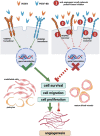Nerve trunk healing and neuroma formation after nerve transection injury
- PMID: 37377855
- PMCID: PMC10291201
- DOI: 10.3389/fneur.2023.1184246
Nerve trunk healing and neuroma formation after nerve transection injury
Abstract
The nerve trunk healing process of a transected peripheral nerve trunk is composed of angiogenesis, nerve fiber regeneration, and scarring. Nerve trunk healing and neuroma formation probably share identical molecular mediators and similar regulations. At the nerve transection site, angiogenesis is sufficient and necessary for nerve fiber regeneration. Angiogenesis and nerve fiber regeneration reveal a positive correlation in the early time. Scarring and nerve fiber regeneration show a negative correlation in the late phase. We hypothesize that anti-angiogenesis suppresses neuromas. Subsequently, we provide potential protocols to test our hypothesis. Finally, we recommend employing anti-angiogenic small-molecule protein kinase inhibitors to investigate nerve transection injuries.
Keywords: angiogenesis; nerve fiber regeneration; peripheral nerve injury; protein kinase inhibitor; scarring; traumatic neuroma.
Copyright © 2023 Huang, Yang, Jiang, Chen, Chang, Zhan and Gong.
Conflict of interest statement
The authors declare that the research was conducted in the absence of any commercial or financial relationships that could be construed as a potential conflict of interest.
Figures







References
-
- Lundborg G. Nerve injury and repair: regeneration, reconstruction, and cortical remodeling. 2nd ed. Philadelphia, PA: Elsevier; (2004). 248 p.
Publication types
LinkOut - more resources
Full Text Sources

